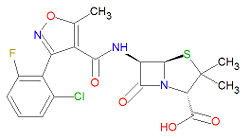Flucloxacillin
|
| |||||||
| flucloxacillin | |||||||
| |||||||
| Uses: | antibiotic drug | ||||||
| Properties: | beta-lactam | ||||||
| Hazards: | see drug interactions | ||||||
| |||||||
Flucloxacillin is a pencillin-like beta-lactam antibiotic that is an analog of cloxacillin. It is used to treat bacterial infections, mostly from aerobic Gram-positive bacteria. Flucloxacillin, and all penicillin-like drugs, may cause anaphylactic shock.
Mechanism of action
Like other penicillin drugs, it inhibits the last stage of bacterial cell wall synthesis by binding to penicillin binding proteins, which inhibits the cross-linking needed to form stable cell walls. This leads to autolysis of the bacteria by autolysins.
Chemistry
Its IUPAC chemical name is (2S,5R,6R)-6-[[3-(2-chloro-6-fluorophenyl)-5-methyl1,2-oxazole-4-carbonyl]amino]-3, 3-dimethyl-7-oxo-4-thia-1-azabicyclo[3.2.0]heptane-2-carboxylic acid and it has molecular formula C19H17ClFN3O5S, giving it a molecular mass of 453.8718 g/mol. Flucloxacillin is stable against degradation by beta-lactamases, including penicillinases, and cephalosporinases.
Drug interactions
Several drugs, including demeclocycline, doxyclycline, methacycline, minocycline. oxytetracycline, rolitetracycline and tetracycline may be antagonists of flucloxacillin. Flucloxacillin may decrease the effects of the contraceptive drugs ethinyl estradiol and mestranol.
Synonyms and brand names
|
Synonyms
|
Brand names
|
External links
The most up-to-date information about Flucloxacillin and other drugs can be found at the following sites.
- Flucloxacillin - FDA approved drug information (drug label) from DailyMed (U.S. National Library of Medicine).
- Flucloxacillin - Drug information for consumers from MedlinePlus (U.S. National Library of Medicine).
- Flucloxacillin - Detailed information from DrugBank.
